Trolls: Character vs. Caricature When Writing Suspects and Antagonists in Mysteries
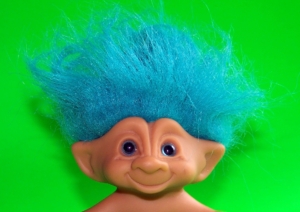 What do trolls have to do with writing suspects and antagonists in mysteries?
What do trolls have to do with writing suspects and antagonists in mysteries?
Trolls?
Trolls: Nasty creatures who live under bridges.
Trolls: Nasty people who bully others on social media.
Trolls: Weird looking collectibles from the 1960s (now the stars of animated movies.)
Trolls: Kristoff’s fun-loving adoptive family in Frozen
Trolls: Amazing works of art from recycled materials by Thomas Dambo.
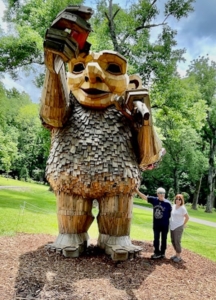 I first learned of Thomas Dambo’s work when I saw a news story about him and his art installations made of recycled materials. He’s considered the world’s leading recycling artist with his work appearing throughout the United States, Europe, and Asia. His more than 125 larger-than-life trolls were created to share his environmental message throughout the world in outdoor installations that use trash to create art within nature.
I first learned of Thomas Dambo’s work when I saw a news story about him and his art installations made of recycled materials. He’s considered the world’s leading recycling artist with his work appearing throughout the United States, Europe, and Asia. His more than 125 larger-than-life trolls were created to share his environmental message throughout the world in outdoor installations that use trash to create art within nature.
The trolls have noticed that “small people” (us humans) are harming the planet. The goal of these giant trolls is to educate humans, whereby they’ll rediscover nature and become thoughtful, caring stewards of our planet. A more positive message than those other trolls who frequent social media, right?
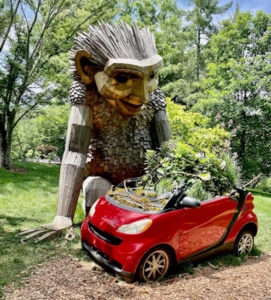 Six of Dambo’s trolls took up residence within the gardens, trees, and wooded areas of the Cheekwood Estate & Gardens in Nashville during this past spring and summer. I was lucky enough to have the chance to visit with them. They’ve since moved on to spend time at the Virginia Aquarium & Marine Science Center in Virginia Beach, VA through Jan 20, 2025. If you have a chance to visit with them, tell them I said hi.
Six of Dambo’s trolls took up residence within the gardens, trees, and wooded areas of the Cheekwood Estate & Gardens in Nashville during this past spring and summer. I was lucky enough to have the chance to visit with them. They’ve since moved on to spend time at the Virginia Aquarium & Marine Science Center in Virginia Beach, VA through Jan 20, 2025. If you have a chance to visit with them, tell them I said hi.
So what do these trolls have to do with writing mysteries? Actually, quite a lot. When we think of trolls, most of us think of ugly, nasty creatures, either real or fictional. But both Thomas Dambo’s recycled trolls, Kristoff’s adopted family, and those weird bygone mini collectables showed us that not all trolls are nasty and that ugly is subjective.
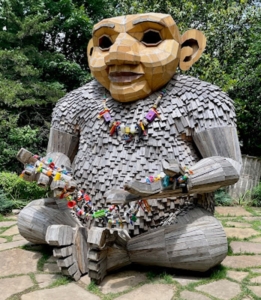 Also, the best villains or antagonists are multi-layered. If they weren’t, they’d be caricatures rather than characters, and no author should be writing Snidely Whiplash-type cardboard villains. That’s why it’s so important to spend as much time developing the goals, motivations, and conflicts of our suspects in our mysteries as we do our protagonists.
Also, the best villains or antagonists are multi-layered. If they weren’t, they’d be caricatures rather than characters, and no author should be writing Snidely Whiplash-type cardboard villains. That’s why it’s so important to spend as much time developing the goals, motivations, and conflicts of our suspects in our mysteries as we do our protagonists.
We’re often asked who is our favorite fictional sleuth, but who is your favorite fictional suspect or antagonist? Post a comment for a chance to win a promo code for a free download of any one of the first eleven audiobooks in my Anastasia Pollack Crafting Mystery Series.
~*~
USA Today and Amazon bestselling and award-winning author Lois Winston writes mystery, romance, romantic suspense, chick lit, women’s fiction, children’s chapter books. Kirkus Reviews dubbed her critically acclaimed Anastasia Pollack Crafting Mystery series, “North Jersey’s more mature answer to Stephanie Plum.” In addition, Lois is a former literary agent and an award-winning craft and needlework designer who often draws much of her source material for both her characters and plots from her experiences in the crafts industry. Learn more about Lois and her books at her website www.loiswinston.com where you can also sign up for her newsletter and follow her on various social media sites.



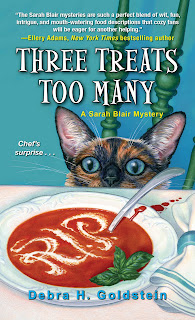



And just like that I love trolls!
They are pretty cool, aren’t they, Donalee?
Hmm…adding trolls to my list of favorite suspects!
LOL! Thanks for commenting, Saralyn!
Lois, thanks for introducing us (me) to the work of Thomas Dambo. A friend of mine has written a very charming children’s book about a kind troll who falls in love with a fairy and is shunned by her family for being crude. As always, you are spot-on about making villains multi-layered. A favorite review of my first book called the antagonist “a villain you love to hate.” Made me feel like I’d created a relatable (though hate-able) character.
Gay, I love when readers tell me they love to hate my villains. It’s great validation.
GREAT ART! Have always had a fondness for trolls.
Debra, I changed my mind about trolls when I saw Frozen, and I love Dambo’s take on them.
Amazing, would love to see these sculptures. Looks much bigger than the Rockies Troll I have on my desk. Great post as usual, Lois
Do a Google search, Donnell. They’re traveling around the country and might wind up near you at some point.
The sweetness of some of the best trolls. Great analogy for our villains, Lois. Thanks.
Thanks for stopping by and commenting, Pam.
I love the trolls! I live outside Chicago, and a whole gang of them oversaw Morton Arboretum for several years. One of them, Joe the Guardian, stood on a hillside and looked out over the expressway at the untold numbers of daily commuters…thank you for this memory! (I wish they would come back!)
—JKB
You never know, Jennifer. They just might.